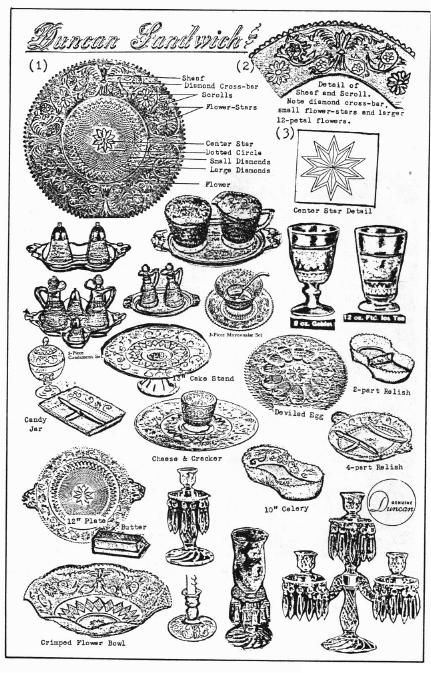National Depression Glass Association
Preserving America's Glass Manufacturing Heritage
Duncan's Sandwich Pattern
by Virginia Scott
Glass Review - October 1985
 Sandwich glass derives its rather strange sounding name from the
Boston & Sandwich Glass Co. which was located in Sandwich, MA. This
famous company produced glass from about 1825 to 1880. In the late
1820's Deming Jarves invented a machine for pressing glass in a mold
and started the industry's first pressed glass operation in America.
Until this time glassware had been made by blowing into a mold. Designs
on glass were either applied, engraved or etched by cutting. Cut and
fancy glass was very expensive and was not available to the general
public.
Sandwich glass derives its rather strange sounding name from the
Boston & Sandwich Glass Co. which was located in Sandwich, MA. This
famous company produced glass from about 1825 to 1880. In the late
1820's Deming Jarves invented a machine for pressing glass in a mold
and started the industry's first pressed glass operation in America.
Until this time glassware had been made by blowing into a mold. Designs
on glass were either applied, engraved or etched by cutting. Cut and
fancy glass was very expensive and was not available to the general
public.
Early pressed glass was heavy and had many bubbles and imperfections. It was soon discovered that by making a faceted design, light would be reflected and imperfections would be less apparent. Small dots were put into the mold in an attempt to get as many facets into the glass as possible. This so-called "Lacy Glass" probably originated in France but soon was made at Sandwich and other plants in the United States. Lacy glass is stippled and has the appearance of textiles or embroidery.
Duncan & Miller Glass Company of Washington, PA brought out their "Early American Lace Glass" about 1925. They later adopted the name "Duncan Sandwich" for this lace glass. Many ads for "Duncan Sandwich" appeared in ads in magazines between 1930 and 1950's.
"A hundred and twenty-eight years ago," one Duncan ad declared, "Deming Jarves made pieces like these in the Cape Cod village of Sandwich. To make the Duncan molds, his star-and-scroll design, probably the best of Early American designs, was caned by hand in solid steel, just as it was at Sandwich. From these true-to-the-original molds come very lovely items." Another ad related, "Your great grandmother may have had something exactly like this. She probably called it "lace glass" or "star and scroll."
"Star and Scroll" is a good term to remember when trying to describe Duncan's Sandwich pattern. The winged sheaf of the pattern has three sections which have points at the end and which are "tied" in the center with a diamond-shaped cross-bar. Examine the labeled design in No. 1 and the detailed design in No. 2. The diamond cross-bar was used only by Duncan, so is an easy way to distinguish the Duncan Sandwich. Another characteristic is the six-pointed flower star or rosette which appears within the curved part of every scroll. The background is formed of very small dots quite close together. Most Duncan items have a star with ten sharp points (No. 3) in the bottom. The star is set in a circle of very small dots and surrounded by an area of small diamonds which, in turn is usually surrounded by one or more rows of larger diamonds which have a pattern of dots and crosses. These patterns vary somewhat from piece to piece, depending on the shape. The design is sharp and well-defined when rubbed with the finger.
During the 1920's, Sandwich pattern was made in crystal, green, amber and a rose. Ruby was added in the 1980's and Chartreuse in 1949.
Duncan & Miller closed in 1955, but Sandwich pattern was continued at Duncan & Miller Division of United States Glass Co. In the 1960's Duncan molds were acquired by Indiana Glass Co. and the pattern has been manufactured for Colony in crystal. These pieces are not marked, so may be difficult to distinguish from old Duncan Sandwich. In 1972 Colony used sixteen Sandwich molds to manufacture Horizon Blue, Lime Green and Sunset (Amberina) color pieces for Montgomery Wards "Century 2" Celebration which commemorated their 100 years in business. Indiana has also used some of the Duncan molds to make "Tiara Sandwich Glass" in red, gold and blue.